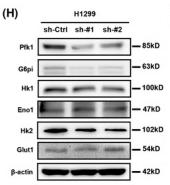Glucose 6 phosphate isomerase Antibody - #DF13660
| Product: | Glucose 6 phosphate isomerase Antibody |
| Catalog: | DF13660 |
| Description: | Rabbit polyclonal antibody to Glucose 6 phosphate isomerase |
| Application: | WB IHC |
| Cited expt.: | WB |
| Reactivity: | Human, Mouse, Rat |
| Prediction: | Pig, Bovine, Horse, Sheep, Rabbit, Dog, Xenopus |
| Mol.Wt.: | 63kDa; 63kD(Calculated). |
| Uniprot: | P06744 |
| RRID: | AB_2846679 |
Related Downloads
Protocols
Product Info
*The optimal dilutions should be determined by the end user. For optimal experimental results, antibody reuse is not recommended.
*Tips:
WB: For western blot detection of denatured protein samples. IHC: For immunohistochemical detection of paraffin sections (IHC-p) or frozen sections (IHC-f) of tissue samples. IF/ICC: For immunofluorescence detection of cell samples. ELISA(peptide): For ELISA detection of antigenic peptide.
Cite Format: Affinity Biosciences Cat# DF13660, RRID:AB_2846679.
Fold/Unfold
AMF; Aurocrine motility factor; Autocrine motility factor; DKFZp686C13233; EC 5.3.1.9; G6PI_HUMAN; Glucose phosphate isomerase; Glucose-6-phosphate isomerase; GNPI; GPI; Gpi1; Hexose monophosphate isomerase; Hexosephosphate isomerase; Neuroleukin; NLK; Oxoisomerase; PGI; PHI; Phosphoglucose isomerase; Phosphohexomutase; Phosphohexose isomerase; Phosphosaccharomutase; SA 36; SA-36; SA36; Sperm antigen 36;
Immunogens
A synthesized peptide derived from human Glucose 6 phosphate isomerase, corresponding to a region within C-terminal amino acids.
- P06744 G6PI_HUMAN:
- Protein BLAST With
- NCBI/
- ExPASy/
- Uniprot
MAALTRDPQFQKLQQWYREHRSELNLRRLFDANKDRFNHFSLTLNTNHGHILVDYSKNLVTEDVMRMLVDLAKSRGVEAARERMFNGEKINYTEGRAVLHVALRNRSNTPILVDGKDVMPEVNKVLDKMKSFCQRVRSGDWKGYTGKTITDVINIGIGGSDLGPLMVTEALKPYSSGGPRVWYVSNIDGTHIAKTLAQLNPESSLFIIASKTFTTQETITNAETAKEWFLQAAKDPSAVAKHFVALSTNTTKVKEFGIDPQNMFEFWDWVGGRYSLWSAIGLSIALHVGFDNFEQLLSGAHWMDQHFRTTPLEKNAPVLLALLGIWYINCFGCETHAMLPYDQYLHRFAAYFQQGDMESNGKYITKSGTRVDHQTGPIVWGEPGTNGQHAFYQLIHQGTKMIPCDFLIPVQTQHPIRKGLHHKILLANFLAQTEALMRGKSTEEARKELQAAGKSPEDLERLLPHKVFEGNRPTNSIVFTKLTPFMLGALVAMYEHKIFVQGIIWDINSFDQWGVELGKQLAKKIEPELDGSAQVTSHDASTNGLINFIKQQREARVQ
Predictions
Score>80(red) has high confidence and is suggested to be used for WB detection. *The prediction model is mainly based on the alignment of immunogen sequences, the results are for reference only, not as the basis of quality assurance.
High(score>80) Medium(80>score>50) Low(score<50) No confidence
Research Backgrounds
In the cytoplasm, catalyzes the conversion of glucose-6-phosphate to fructose-6-phosphate, the second step in glycolysis, and the reverse reaction during gluconeogenesis. Besides it's role as a glycolytic enzyme, also acts as a secreted cytokine: acts as an angiogenic factor (AMF) that stimulates endothelial cell motility. Acts as a neurotrophic factor, neuroleukin, for spinal and sensory neurons. It is secreted by lectin-stimulated T-cells and induces immunoglobulin secretion.
Phosphorylation at Ser-185 by CK2 has been shown to decrease enzymatic activity and may contribute to secretion by a non-classical secretory pathway.
ISGylated.
Cytoplasm. Secreted.
Belongs to the GPI family.
Research Fields
· Metabolism > Carbohydrate metabolism > Glycolysis / Gluconeogenesis.
· Metabolism > Carbohydrate metabolism > Pentose phosphate pathway.
· Metabolism > Carbohydrate metabolism > Starch and sucrose metabolism.
· Metabolism > Carbohydrate metabolism > Amino sugar and nucleotide sugar metabolism.
· Metabolism > Global and overview maps > Metabolic pathways.
· Metabolism > Global and overview maps > Carbon metabolism.
References
Application: WB Species: Human Sample: H1299 cells
Application: WB Species: human Sample: H1299 cells
Restrictive clause
Affinity Biosciences tests all products strictly. Citations are provided as a resource for additional applications that have not been validated by Affinity Biosciences. Please choose the appropriate format for each application and consult Materials and Methods sections for additional details about the use of any product in these publications.
For Research Use Only.
Not for use in diagnostic or therapeutic procedures. Not for resale. Not for distribution without written consent. Affinity Biosciences will not be held responsible for patent infringement or other violations that may occur with the use of our products. Affinity Biosciences, Affinity Biosciences Logo and all other trademarks are the property of Affinity Biosciences LTD.






